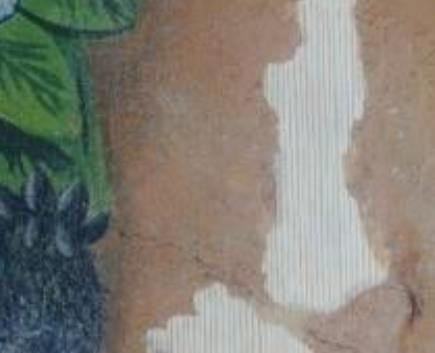Reintegração pictórica das pinturas murais da Ermida de Nossa Senhora da Piedade, Loulé: escolhas técnicas
DOI:
https://doi.org/10.14568/cp2021016Palavras-chave:
Reintegração pictórica, Pintura mural, Lacunas, Metodologia e técnicas de reintegração, Protecção finalResumo
Dado o seu impacte na percepção dos observadores, a reintegração de lacunas em obras de arte pictórica é uma das operações mais delicadas e debatidas da conservação e restauro. Neste texto é explicitada a metodologia que norteou as escolhas técnicas relativas à reintegração cromática das lacunas e à aplicação de protecção das superfícies nas pinturas murais da Ermida de Nossa Senhora da Piedade, em Loulé. É adicionalmente feita referência à forma como estas escolhas/metodologia articularam os valores simbólicos e religiosos das pinturas da Ermida com a deontologia da conservação e restauro. Muito embora o tipo de intervenção e respectivo resultado final deva sempre ser debatido com as partes interessadas e eventuais consultores/as, as escolhas técnicas caberão necessariamente ao/à conservador/a-restaurador/a, que, por isso, deve ter formação, experiência e sensibilidade adequadas à análise crítica necessária à tomada deste tipo de decisões.
Downloads
Referências
[1] Fundel, S.; Drewello, R.; Hoyer, S.; Kügel, B., ‘How do fragmentary images affect us?’, Studies in Conservation 53(sup1) (2008) 27-32, https://doi.org/10.1179/sic.2008.53.Supplement-1.27.
[2] Brandi, C., Teoria do restauro, Edições Orion, Amadora (2006).
[3] Bailão, A., ‘O gestaltismo aplicado à reintegração cromática de pintura de cavalete’, Estudos de Conservação e Restauro 1 (2009) 128-139.
[4] Agulli, G.; Silva, L., ‘Treatment of lacunae, Gestalt psychology and Cesare Brandi. From theory to practice’, in 3rd International Meeting on Retouching of Cultural Heritage RECH3, eds. A. Bailão, F. Henriques, A. Bidarra, Escola Artística e Profissional Árvore, Porto (2015) 95-102.
[5] Brajer, I., ‘To retouch or not to retouch? – Reflections on the aesthetic completion of wall paintings’, in CeROArt. Conservation, exposition, Restauration d’Objets d’Art (HS Junho 2015), https://journals.openedition.org/ceroart/4619 (acesso em 2018-09-01).
[6] Muñoz-Viñas, S., Contemporary Theory of Conservation, Elsevier-Butterworth Heinemann, Oxford (2005).
[7] van de Vall, R., ‘Painful decisions: philosophical considerations on a decision-making model’, in Modern Art: Who Cares?, eds. I. Hummelen & D. Sillé, Archetype Publications, Londres (2005) 196-200.
[8] Lameira, F.; Gordalina, R., ‘Ermida Nossa Senhora da Piedade / Santuário de Nossa Senhora da Piedade – Mãe Soberana’ (2004), in SIPA – Sistema de Informação para o Património Arquitectónico, Direcção Geral do Património Cultural, http://www.monumentos.pt/Site/APP_PagesUser/SIPA.aspx?id=5625 (acesso em 2018-09-01).
[9] Ermida de Nossa Senhora da Piedade – Loulé, Câmara Municipal de Loulé, (s.d.), http://www.cm-loule.pt/pt/140/ermida-de-nossa-senhora-da-piedade-%E2%80%93-loule.aspx (acesso em 2018-09-05).
[10] Mãe Soberana, em Loulé: a grande romaria algarvia, Diocese do Algarve, http://turismo.diocese-algarve.pt/tradicoes-do-algarve/item/695-mae-soberana-a-romaria-do-algarve (acesso em 2018-09-05).
[11] Aleixo, J., ‘O culto a Nossa Senhora da Piedade, Mãe Soberana dos Louletanos, em Loulé (1806-2013)’,dissertação de mestrado em História Contemporânea, Universidade Nova de Lisboa, Lisboa (2013), https://run.unl.pt/handle/10362/12222.
[12] Serra, M.P., ‘Conservação e restauro da Ermida Nossa Senhora da Piedade’, Al-úlyá 5 (1996) 265-275, http://www.cm-loule.pt/pt/menu/1397/al-ulya-n-5.aspx (acesso em 2018-09-07).
[13] Carlo-Stella, C., ‘Religious heritage as a meeting point for dialogue: the Cathedral Workshops experience’, in Conservation of Living Religious Heritage. Proceedings of the 2003 ICCROM Forum Living Religious Heritage: Conserving the Sacred, eds. H. Stovel, N. Stanley-Price, R. Killick, ICCROM, Roma (2005) 107-112, https://www.iccrom.org/sites/default/files/ICCROM_ICS03_ReligiousHeritage_en.pdf (acesso em 2018-08-27).
[14] ICATHM. Carta de Veneza – Sobre a Conservação e Restauro dos monumentos e sítios (1964), http://www.patrimoniocultural.gov.pt/media/uploads/cc/CartadeVeneza.pdf (acesso em 2020-06-15).
[15] Appelbaum, B., ‘Criteria for treatment: reversibility’, Journal of the American Institute for Conservation 26 (2) (1987) 65-73.
[16] Mora, P.; Mora, L.; Philippot, P., La Conservazione delle Pitture Murali, 2a Ed., ICCROM e Editrice Compositori, Roma (2001).
[17] Ameringer, C. S. – ‘Maimeri Restauro Varnish Colours’, in Painting Conservation Catalog. Vol. III: Inpainting, compiled by C. A. Metzger; C. Maines; J. Dunn, Paintings Specialty Group of the American Institute for Conservation of Historic and Artistic Works, Washington, DC (2011) 193-198.
[18] Braamcamp de Figueiredo, A.; Carvalho, S., ‘As três dimensões da cor na reintegração cromática diferenciada: a importância da luminosidade’, Ge-conservación 9 (2016) 21-30.
[19] Weyer, A.; Roig Picazo, P.; Pop, D.; Cassar, J.; Özköse, A.; Vallet, J.M.; Srša, I. (eds.), EwaGlos - European Illustrated Glossary of Conservation Terms for Wall Paintings and Architectural Surfaces, Hornemann Institut, Michael Imhof Verlag, Petersberg, (2015), https://doi.org/10.1017/CBO9781107415324.004.
[20] Ashley-Smith, J., ‘Losing the edge: the risk of a decline in practical conservation skills’, Journal of the Institute of Conservation 39(2) (2016) 119-132, https://doi.org/10.1080/19455224.2016.1210015.
[21] de la Rie, E.R.; Quillen Lomax, S.; Palmer, M.; Deming Glinsman, L.; Maines, C.A., ‘An investigation of the photochemical stability of urea-aldehyde resin retouching paints: removability tests and colour spectroscopy’, Studies in Conservation 45(sup1) (2000) 51-59, http://dx.doi.org/10.1179/sic.2000.45.Supplement-1.51.
[22] Arslanoglu, J.; Learner, T., ‘The evaluation of Laropal A81: Paraloid B‐72 polymer blend varnishes for painted and decorative surfaces–appearance and practical considerations’, The Conservator 25(1) (2001) 62-72, https://doi.org/10.1080/01410096.2001.9995165.
[23] de la Rie, E.R.; McGlinchey, C.W., ‘New synthetic resins for picture varnishes’, Studies in Conservation 35(sup1) (1990) 168-173, https://dx.doi.org/10.1179/sic.1990.35.s1.036.
[24] de la Rie, E. R.; Delaney, J. K.; Morales, K. M.; Maines, C. A.; Sung, L.P., ‘Modification of Surface Roughness by Various Varnishes and Effect on Light Reflection’, Studies in Conservation 55(2) (2010) 134-143, https://dx.doi.org/10.1179/sic.2010.55.2.134.
[25] Borgioli, L., Regal Varnish (Relazione Tecnica), CTS (2015) https://www.ctseurope.com/en/scheda-prodotto.php?id=955 (acesso em 2018-09-3).
[26] Caetano, J., Proença, N., Vilaça de Sousa, C., ‘Conservation as an act between time’, in International Seminar Theory and Practice in Conservation: A Tribute to Cesare Brandi, eds. J. Delgado Rodrigues & J.M. Mimoso, LNEC, Lisboa (2006) 119-126.

Downloads
Publicado
Como Citar
Edição
Secção
Licença
O presente trabalho é distribuído nos termos da Licença Creative Commons (CC BY-NC 4.0) que permite a utilização, partilha e reprodução para fins não comerciais e sem modificações, desde que o autor e fonte original sejam citados.
O Copyright permanece com os autores.












